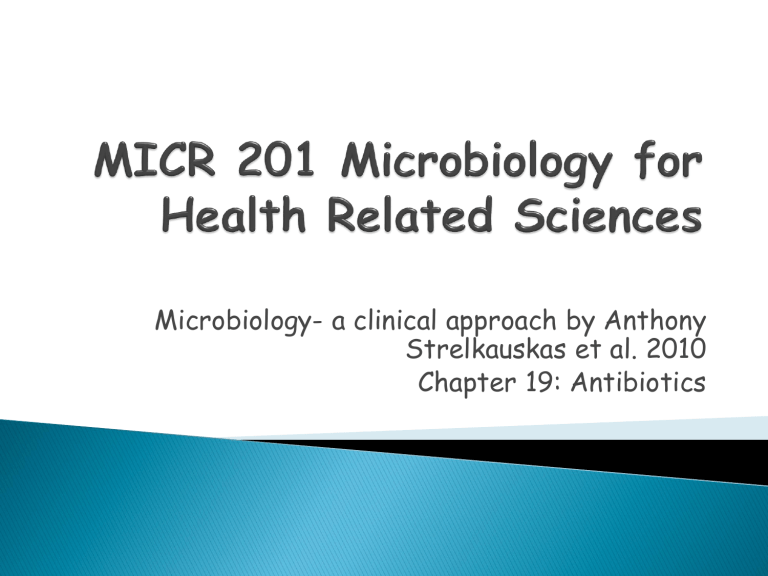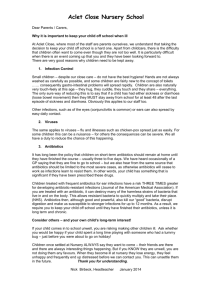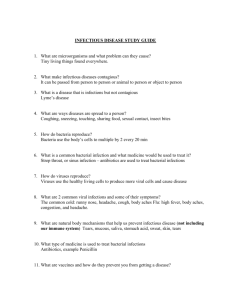MICR 201 Microbiology for - Cal State LA

Microbiology- a clinical approach by Anthony
Strelkauskas et al. 2010
Chapter 19: Antibiotics
Antibiotics have changed the face of health care.
They have drastically reduced the number of deaths due to infection.
Infectious disease are among the few diseases we can actually cure with drugs.
Original term was used for antibacterial compounds produced by living microorganisms.
These were products of secondary metabolic pathways and served to defend the producer against other microbes in the environment.
Some of them were chemically modified.
Chemotherapeutics were entirely chemically synthesized compounds.
Today, the term “antibiotics” many times used for any drug inhibiting bacteria.
No major discoveries of natural antibiotic substances have occurred for several years.
Efforts have now shifted to modifying existing antibiotics.
Searching in new places for potential antibiotics has also gained in prominence.
The original natural molecules used by humans as antibiotics have a very narrow spectrum.
◦ Penicillin activity is typically against Gram-positive bacteria.
Natural molecules can be chemically modified making it possible to broaden their spectrum.
Antibiotics are classified as either broadspectrum or narrow-spectrum.
Broad spectrum antibiotics are active against a wide range of bacteria including Gram-positive and Gram-negative bacteria.
◦ Ciprofloxacin is a broad spectrum antibiotic.
The ideal antibiotic should target structures and processes only found in the pathogen.
A fundamental criterion of antibiotics for medical use is selective toxicity .
◦ The antibiotic should be destructive to the disease-causing organism but have no effect on the human host.
The first antibiotic discovered, penicilin, showed high selective toxicity.
Many antibiotic molecules are toxic if administered at high concentrations.
Toxicity necessitates extensive testing.
It can take years and cost millions of dollars.
, rifampin
The bacterial cell wall
The bacterial plasma membrane
Synthesis of bacterial proteins
Bacterial nucleic acids
Bacterial metabolism
The bacterial cell wall is built by many enzymatic reactions.
◦ These enzymes can be used as targets of antibiotic molecules.
The cell wall is made up of the peptidoglycan molecules NAG and NAM.
◦ They are cross-linked through activity of transglycosylase and transpeptidase enzymes.
◦ Many antibiotics inhibit the activity of these two enzymes.
Results in improper cell wall cross-linking
Organism not able to withstand cell osmotic pressure.
◦ Some antibiotics inhibit the production of peptidoglycan precursors molecules and their transport across the cell membrane.
Penicillin-binding proteins
(PBPs) are involved in the construction of the cell wall.
Penicillins contain a β-lactam ring which binds to these proteins.
New cell wall continuously built during active growth
◦ Penicillin prevents the formation of an intact cell wall.
◦ Penicillin is most effective during this phase.
http://en.wikipedia.org/wiki/Betalactam_antibiotic
All forms of penicillin contain the b -lactam ring.
Chemically changing the side chain can change:
Antimicrobial activity
Resistance to stomach acid
Overall half-life in body
More than 50 derivatives
Cephalosporins have similar activity to penicillins.
◦ They prevent the construction of a stable cell wall.
Cephalosporins have a much greater affect on
Gram-negative bacteria than penicillins because they can enter the porines of Gram-negative bacteria.
◦ They are naturally broad spectrum antibiotics .
◦ They are not susceptible to some of the β-lactamase enzymes.
Cephalosporins are frequently used both preoperatively and postoperatively.
Frequent use has increased resistance.
Glycopeptide antibiotics are derived from
Streptomyces organisms.
◦ Vancomycin is a glycopeptide antibiotic.
Glycopeptide antibiotics have serious side effects .
◦ Toxicity level reduced in recent years by improving purification.
They inhibit cell wall synthesis by forming a complex with the substrates that make up peptidoglycan.
They cannot penetrate the porins of Gram-negative cells.
◦ Narrow spectrum antibiotics restricted to Gram-positive bacteria.
Vancomycin used to be the drug of choice for MRSA.
However, there are now vancomycin resistant S. aureus strains (VRSA) described.
These antibiotics target mycolic acids and are used against Mycobacterium tuberculosis .
◦ Their cell walls are modified by incorporation of mycolic acids.
Isoniazid inhibits the synthesis of mycolic acid.
Ethambutol inhibits the incorporation of mycolic acids into the cell wall.
Used in combination (plus rifampin) for Tb therapy.
The plasma membrane is involved with important physiological functions.
◦ It is a prime target for antibiotics.
◦ Any disruption of the membrane destroys the bacteria.
Unfortunately the structure of the bacterial plasma membrane is similar to the eukaryotic plasma membrane.
This does not allow for selective toxicity.
One of the few antibiotics that target the bacterial cell membrane is polymyxin B.
Polymyxin B acts like a detergent.
Ribosomes site of protein synthesis
Binding of mRNA, tRNA, decoding, peptide elongation, detachment
Disruption in production of protein devastating to cell.
Ribosomes of prokaryotes are not the same as eukaryotes.
70S with 30S+50S
This allows for selective toxicity .
Eukaryotic cells have mitochondria ribosomes similar to prokaryotes
There is antibiotic
.
interference in eukaryotic cell function if antibiotics given in excessive amounts.
Aminoglycosides
◦ Gentamicin, tobramycin, spectinomycin, kanamycin, streptomycin
Tetracyclines
◦ Tetracycline, doxycycline
Macrolide
◦ Erythromycin, clarithromycin, azithromycin
Lincosamide
◦ Clindamycin
Amphenicols
◦ Chloramphenicol
Oxazolidinone
◦ Linezolid
Streptogramins
◦ Pristanamycin, streptogramin
VRE
Streptomyces species make pristinamycin and streptogramin .
◦ They work synergistically to inhibit translation at the
50S subunit.
◦ Both have been synthetically modified.
◦ They make up the antibiotic Synercid®.
◦ Approved for the treatment of vancomycin-resistant enterococci (VRE).
DNA and RNA are universal components.
◦ Their structure in bacteria is no different from their structure in humans.
◦ This does not allow for selective toxicity.
Two families of synthetic compounds can target bacterial nucleic acids.
◦ Rifamycins including rifampin inhibit transcription.
Used for Tb treatment
◦ Quinolones including ciprofloxacin target bacterial topoisomerase gyrase and block DNA replication and DNA repair.
Used for urinary tract infections, osteomyelitis, communityacquired pneumonia and gastroenteritis, and anthrax
Two targets for inhibiting bacterial growth:
◦ Metabolic pathways at the plasma membrane.
◦ Production of nucleic acid precursors; folic acid from para-aminobenzoic acid (PABA)
◦ Humans consume folic acid with diet
Sulfa drugs block folic acid synthesis
Sulfa drugs use longer any antibacterial agent.
Sulfamethoxazole used in combination with trimethoprim; treat urinary tract infections.
Viruses pose a different set of problems for antibiotic therapy.
◦ They are obligate intracellular parasites and use cell machinery for replication.
◦ Drugs that can eliminate the virus are dangerous to non-infected cells.
◦ This makes selective toxicity difficult .
Many viruses difficult to grow.
◦ It is difficult to test potential antiviral drugs.
Many acute viral infections have a short duration.
The lack of rapid tests means it is difficult to differentiate between various viral infections.
Successful antiviral drugs must eliminate all virions.
The escape of even one virion could restart the infectious cycle.
Inhibition of uncoating
◦ Amantadine for Influenza A virus infections
Nucleoside analogues block and terminate viral nucleic acid replication
◦ Acyclovir (and Valtrex® and Famvir® ): Herpes simplex virus (HSV) infections
◦ Gancyclovir: Cytomegalovirus (CMV) infections
◦ Ribavirin : Lassa fever, Hantavirus infections, also Hepatitis
C (in combination with INF a )
Nonnucleoside polymerase inhibitors
◦ Foscarnet: HSV and CMV resistant to nucleoside analogues
Neuraminidase inhibitor
◦ Zanamivir : Influenza virus
All anti-HIV drugs have numerous side effects
Common side effects include nausea, vomiting, headache, fatigue, weakness, and/or muscle pain.
Other side effects included changes in body fat distribution
(lipodystrophy), inflammation, insomnia, and kidney disorders.
http://drugster.info/medic/term/lipodystrophysyndrome/
Reverse transcriptase inhibitors
◦ Nucleoside analogues such as AZT (azidothymidine)
Prevent successful synthesis of cDNA by RT
◦ Non-nucleoside analogue RT inhibitors
Bind non-competitively to RT to block its polymerization function
◦ Nucleotide analogues
Work similar to the nucleoside analogues
Protease inhibitors
◦ Prevent cleavage of polyproteins (by viral protease) required to make mature virus
Integrase inhibitors
Fusion inhibitors
Combination therapy – helps prevent the development of resistant strains
HAART - highly active anti-retroviral therapy (3 or more different classes of drugs in combination)
◦ Serious long-term side effects
accumulation of lactic acid in the bloodstream
physical and metabolic changes that cause changes in fat distribution
cholesterol and glucose abnormalities that can lead to a risk of heart disease.
◦ Long-term use of the drugs can also promote the development of drug-resistant strains of HIV.
http://emedicine.medscape.com/article/1533218-overview
The emergence of diseases that render a host immunocompromised has led to increased secondary fungal infections.
Drugs used for fungal infection have selective toxicity issues.
◦ Fungi are eukaryotes .
◦ Attacking common targets can cause serious side effects .
Major antifungal drugs
◦ Griseofulvin
◦ Polyenes (Amphotericin B)
◦ Azoles (clotrimazole, miconazole, ketoconazole, fluconazole)
Other antifungal drugs
◦ Flucytosine
◦ Pentamidine
Griseofulvin
is produced by a species of the fungus Penicillium.
Administered orally, effective superficial fungal infections.
React with keratin.
Blocks formation of microtubules.
Inhibits mitosis in fungi.
http://www.myfootshop.com/detail.asp
?condition=onychomycosis
Polyenes are produced by the soil bacterium
Streptomyces.
They interact with sterols and increase the permeability of the plasma membrane.
They must be used with caution because of side effects.
Amphotericin B has high renal toxicity.
◦ Serum levels are closely monitored
Azoles inhibit the production of sterols.
Clotrimazole and miconazole
◦ Sold without a prescription
◦ Routinely used topically against athlete’s foot and vaginal yeast infection
Ketoconazole
◦ Is a broad spectrum derivative for systemic fungal infections
◦ Can be taken orally
◦ Less toxic than amphotericin B
Fluconazole and itraconazole
◦ Are the least toxic azoles
◦ Widely used for systemic fungal infections
Flucytosine
interferes with DNA and RNA synthesis.
◦ Taken up preferentially by fungi.
◦ High level of toxicity in kidney and bone marrow
Pentamidine
bind to fungal DNA.
◦ Used in treatment of Pneumocystis pneumonia http://www.healthpic.com/pneumocystis-cariniipneumonia-in-hiv/
The development of drugs for parasitic infections has lagged behind.
◦ Parasitic infections do not occur often in developed nations.
◦ Low profit incentive for corporate drug company development.
Two widely used anti-parasitic drugs are:
◦ Quinine
◦ Metronidazole
Quinine has been used as a treatment for malaria since the 1600s
It has been chemically modified into several synthetic forms.
Chloroquine has been widely used.
Metronidazole is one of the most widely used antiprotozoan drugs.
◦ Sold under the name Flagyl®
It is the drug of choice for:
◦ Vaginitis resulting from
Trichomonas vaginalis
◦ Giardiasis
◦ Amebic dysentery.
It interferes with anaerobic metabolism.
Trichomonas vaginalis
Anti-helminthic drugs have also been largely ignored until recently.
◦ Affected populations were not found in developed countries.
◦ The popularity of sushi has led to an increase in tapeworm infestations.
◦ Increased world travel has also increased helminth infections.
Important drugs are
◦ Niclosamide
◦ Praziquantel
◦ Mebendazole
◦ Ivermectin
Niclosamide is the choice of treatment for these infections.
◦ Inhibits the production of ATP
Praziquantel is also the drug of choice for fluke diseases.
◦ Increases the permeability of plasma membranes for
Ca +2 .
◦ It induces muscle spasms in the worm and dislodges the worm.
◦ This exposes antigenic sites for attack by the host immune system.
Mebendazole is used against these infections.
◦ It disrupts microtubule formation.
◦ This affects the motility of the worm.
Ivermectin is also used.
◦ It paralyzes the worm.
◦ This induces the worm to exit the body.
http://microbeworld.org/image s/stories/twip/ascaris_from_c hild.jpg
There have been no new discoveries of natural antibiotics in decades.
Microorganisms produce toxic chemicals as part of their natural defense.
Antibiotics can be broad or narrow spectrum.
Chemical modification of natural antibiotics can broaden their spectrum.
Some bacteria produce an enzyme called beta-lactamase that inhibits the reactivity of penicillin.
Antibiotics must be selectively toxic but most antibiotics will have side effects.
The five prime targets for antibiotics are the cell wall, the plasma membrane, the ribosome, nucleic acids, and metabolic synthesis pathways.
Viruses present problems for antibiotic treatment because they are obligate intracellular parasites and use the host machinery for replication.
Antifungal drugs have serious side effects because fungi are eukaryotic cells.
The development of new drugs is an expensive and time-consuming process.
Drugs against parasitic protozoans and helminths have been slow to be developed because these infections occur mostly in developing countries.






